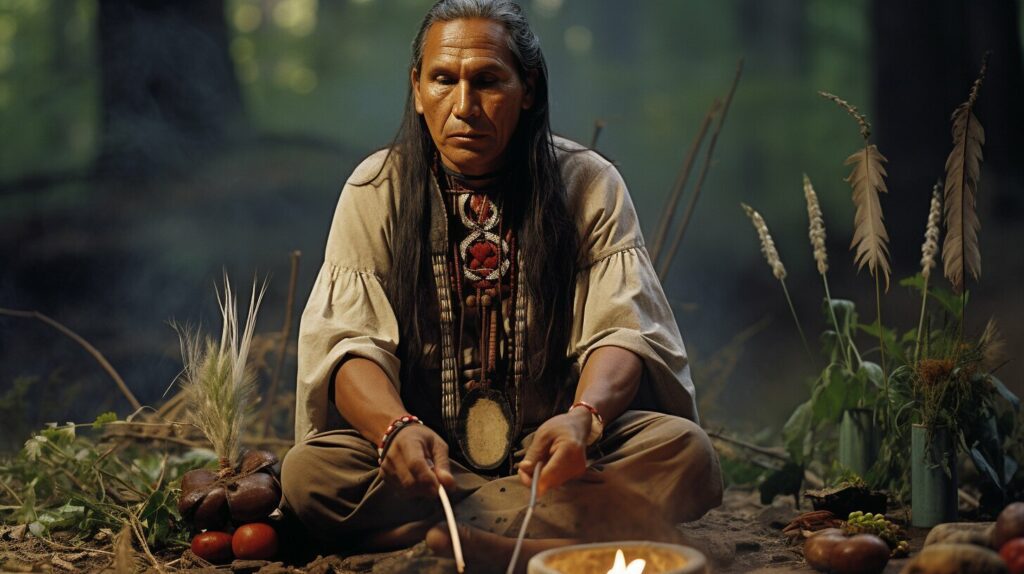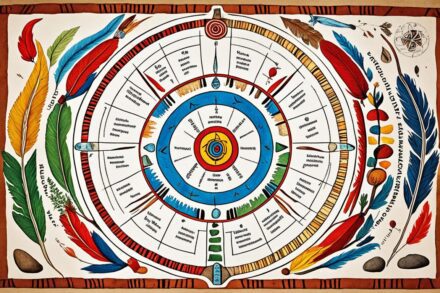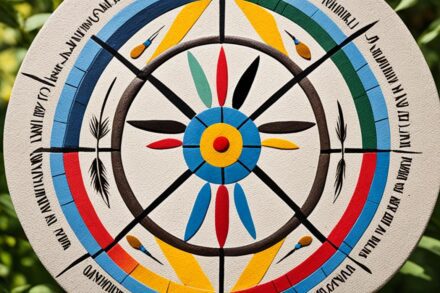There is an incredible mystical world that you might not yet have explored. It’s the ancient realm of Native American Healing Rituals, a captivating practice holding centuries of wisdom and spiritual connection. This profound tradition, deeply rooted in spirituality, is much more than mere folklore or superstition. It’s a culture’s lifeblood, a collection of time-honored rituals that are believed to promote physical, emotional, and spiritual healing. The beauty found within these practices is profound, echoing the respect and connection these communities share with nature. Get ready to embark on an enlightening journey that invites you to resonate with the ancient rhythms of healing, spirituality, and Nature’s cyclic process, as found within Native American Healing Rituals.
The Role of Rituals in Native American Culture
Central to Native American culture are rituals. These are seen as vital practices connecting physical bodies to the spiritual world. Each ceremony or rite has a profound meaning, serving to bond the community and maintain balance within it.
The Importance of Rituals
Rituals serve as a bridge between the human and the spiritual world, a way to not only honor beings and forces that exist beyond our understanding but also to ensure a harmonious co-existence. They are considered essential in maintaining balance in one’s life and the universe at large.
Rituals as a Tool for Community Building
Each ritual serves to reinforce the bonds of the community, reminding individuals that they are part of a larger interconnected entity. Whether it is celebrating a rite of passage, seeking healing, or marking a significant event, all participating members feel a renewed commitment to their shared identity.
Spiritual Significance of Rituals
In the Native American worldview, spirituality pervades all aspects of life. Rituals serve as a pathway to this spiritual realm, grounding its participants in belief systems that honor the living world, their ancestors, nature, and all unseen forces that shape their existence.
Historical Overview of Native American Healing Rituals
Native American healing rituals have a rich and varied history, changing and evolving in response to both internal and external influences.
Pre-European Influence
Before the arrival of Europeans, Native American healing rituals were practiced widely, often differing markedly from tribe to tribe. These systems, deeply rooted in their specific cultures, were adapted to the unique needs and beliefs of each community.
Impact of European Contact
The arrival of Europeans brought enormous disruption to Native American lives and traditions, including their healing rituals. Many practices were outlawed, suppressed, or distorted by colonial powers, leaving a lasting negative impact.
The Survival and Adaptation of Rituals in Modern Times
Despite these adversities, Native American healing rituals survived and continued to evolve. In modern times, there’s a resurgence and reclamation of these ancestral practices. They co-exist alongside modern medicine, often integrated into holistic healthcare approaches.

Types of Native American Healing Rituals
Healing rituals play a significant role in Native American systems of medicine. These rituals can address physical, spiritual, and emotional health.
Rituals for Physical Healing
These rituals often involve the use of medicinal plants, chanting, and other elaborate ceremonies. They are designed to restore physical health and balance within an individual.
Rituals for Spiritual Healing
Spiritual healing deals with illness or imbalance perceived to originate from the spiritual realm. This could involve appeasing spirits, ancestral mediation, or performing specific rites to restore spiritual harmony.
Rituals for Emotional Healing
Native American healing traditions consider emotional well-being central to good health. Rituals for healing emotional trauma or disturbances often involve guided meditation, narrative therapy, and communal support, among other things.
Principles Underlying Native American Healing Rituals
Native American healing rituals are guided by deeply ingrained principles that reflect their worldview.
Belief in Supernatural Powers
Observed in all healing rituals are elements of supernatural communication and intervention. They believe in a world beyond the physical and that spiritual beings and forces affect life in the human realm.
Interconnectivity with Nature
Nature is deeply respected and recognized as a source of healing energy. Each element, creature, or plant has a role and purpose, their use in rituals demonstrating the interconnected relationship Native American cultures have with the natural world.
Respect for the Wisdom of Ancestors
Ancestors are honored for their wisdom and guidance. Rituals often involve calling upon them for strength or insight, reflecting the value placed on generational knowledge.
Role of Healers in Native American Healing Rituals
Healers play vital roles in the practice and continuance of Native American healing rituals.
Selection and Training of Healers
Healers are often selected through signs deemed significant by tribal elders. They undergo rigorous training, learning medicinal practices, performing rituals, understanding the intricate relations between humans and the spiritual world.
Healers as Spiritual Leaders
A healer is not only a medicine person but also plays the role of spiritual guide and teacher. Their responsibilities extend beyond physical healing to leading religious ceremonies, counseling, and preserving cultural heritage.
Responsibilities and Challenges of Healers
Healers face numerous responsibilities and challenges. From ensuring the health of community members to maintaining cultural continuance, their tasks are daunting. Yet, they continue, driven by an unwavering commitment to their people and culture.
Symbolism in Native American Healing Rituals
Symbolism is a crucial aspect of Native American rituals, carrying profound meanings.
Use of Color
Colors play a significant role in rituals, with each color often corresponding to a specific direction, element, or spiritual being. For example, the color green might be associated with the earth and healing.
Power of Shapes and Patterns
Shapes and patterns also have symbolic meaning. A circle might denote the cyclical nature of life, and specific patterns could be used to represent different spirits or ancestors.
Significance of Animals and Plants
Animals and plants often have symbolic meaning, embodying different virtues, messages, or spirits. For example, an eagle might be seen as a messenger between humans and the divine, and sage may be used for its purifying qualities.

Native American Healing Rituals and Modern Medicine
The intersection of Native American healing rituals and modern medicine is an evolving narrative.
Integration of Traditional Practices in Modern Medicine
Today, there’s a growing recognition of the benefits of integrating traditional practices into modern healthcare. Some treatment centers incorporate Native American healing rituals into their practices, offering a holistic approach to care.
Controversy and Challenges
However, this integration isn’t without controversy. Issues of cultural appropriation, misunderstanding, and misrepresentation persist. Some medical practitioners may discount the efficacy of these rituals, while others might exploit them without understanding their cultural significance.
Success Stories and Potential Benefits
Despite these challenges, success stories abound. Many have benefitted from the holistic nature of these practices, experiencing healing that involves their cultural beliefs, emotional well-being, social connections, body, and soul.
Protection and Respect for Native American Healing Rituals
As interest in, and use of, these rituals grow, it’s critical to respect and protect them.
Protection of Intellectual Property
With traditional knowledge often vulnerable to exploitation, efforts must be made to protect the intellectual property rights of indigenous peoples and their healing practices.
Understanding and Respecting Cultural Sensitivity
It’s essential for outsiders to approach these practices with respect and understanding, recognizing their deep cultural significance and the sacred nature of many rituals.
Promoting Cultural Diversity and Inclusion
Valuing these healing rituals contributes to the promotion of cultural diversity, demonstrating the importance of different perspectives and approaches to health and well-being.

Case Study: Healing Rituals of the Navajo Tribe
Navajo healing rituals provide an example of the rich tapestry of Native American healing practices.
Historical Background
The Navajo have a long history of healing practices. They were renowned for their sophisticated knowledge of herbs, minerals, and rituals designed to cure illness and restore balance.
Significant Healing Rituals
One key healing ritual is the Blessing Way, aimed at maintaining harmony in one’s life. Another is the Nightway, a nine-night healing ceremony intended to restore balance and health.
Role of Healers in Navajo Tribe
In the Navajo Tribe, the healers, known as medicine men or women, occupy a revered position. They receive intensive training and are responsible for leading healing ceremonies, providing counsel, and ensuring the cultural continuance of their people.
Case Study: Healing Rituals of the Iroquois Tribe
The Iroquois Tribe also has a vibrant history of healing rituals.
Historical Background
The Iroquois, constituting several nations, have a rich tradition involving clan systems, matrilineal descent, and intricate healing practices.
Significant Healing Rituals
Their Midwinter Ceremony, an annual event, is an important healing and THANKSGIVING ritual. The medicine societies of the Iroquois also hold various ceremonies for healing.
Role of Healers in Iroquois Tribe
In the Iroquois tribes, the healer, often referred to as a medicine person, performs an essential role in the community, undertaking healing rituals, providing guidance, and ensuring the continuation of cultural practices.
Understanding and respecting the diverse healing rituals of Native American tribes provides insight into a worldview where everything is interconnected, and well-being is a balance of body, mind, spirit, community, and environment. As we navigate the complexities of modern life and medicine, these traditional practices remind us of other significant forms of healing we might have forgotten.
Native American Healing
For those interested in exploring Native American healing practices, here are three authoritative and comprehensive websites offering a wealth of information, resources, and services:
- Authentic American Indian Native Healer (RavenintheWind.com): Operated by Wind Raven, a Native American healer of the Yaqui nation, this website offers insights into various healing practices, spiritual cleansings, and blessings. It features a variety of spiritual items such as Dream Catchers, Spirit Bears, and Medicine Bags. The site emphasizes the importance of spirituality in healing and offers personal prayers and a list of natural herbs and medicines for improving wellbeing.
- Visit: http://raveninthewind.com/
- American Indian Health Service of Chicago, Inc. (AIHS): This site provides detailed information on the Four Sacred Medicines (Tobacco, Cedar, Sage, and Sweetgrass), highlighting their traditional uses, medicinal properties, and roles in purification and healing ceremonies. It explains how these plants are used in various practices to promote physical and spiritual health, and the historical context of their use in Native American ceremonies.
- Visit: https://aihschgo.org
- Native Wellness Institute: Dedicated to promoting the well-being of Native people through programs and trainings that embrace the teachings and traditions of our ancestors, the Native Wellness Institute offers a range of services including wellness training, leadership development, and youth programs. They host Wellness Wednesdays on Facebook Live, offering a space for sharing wisdom and guidance.
These sites offer a deep dive into the rich tradition of Native American healing practices, providing resources for those seeking to learn more or engage with these traditions personally.
